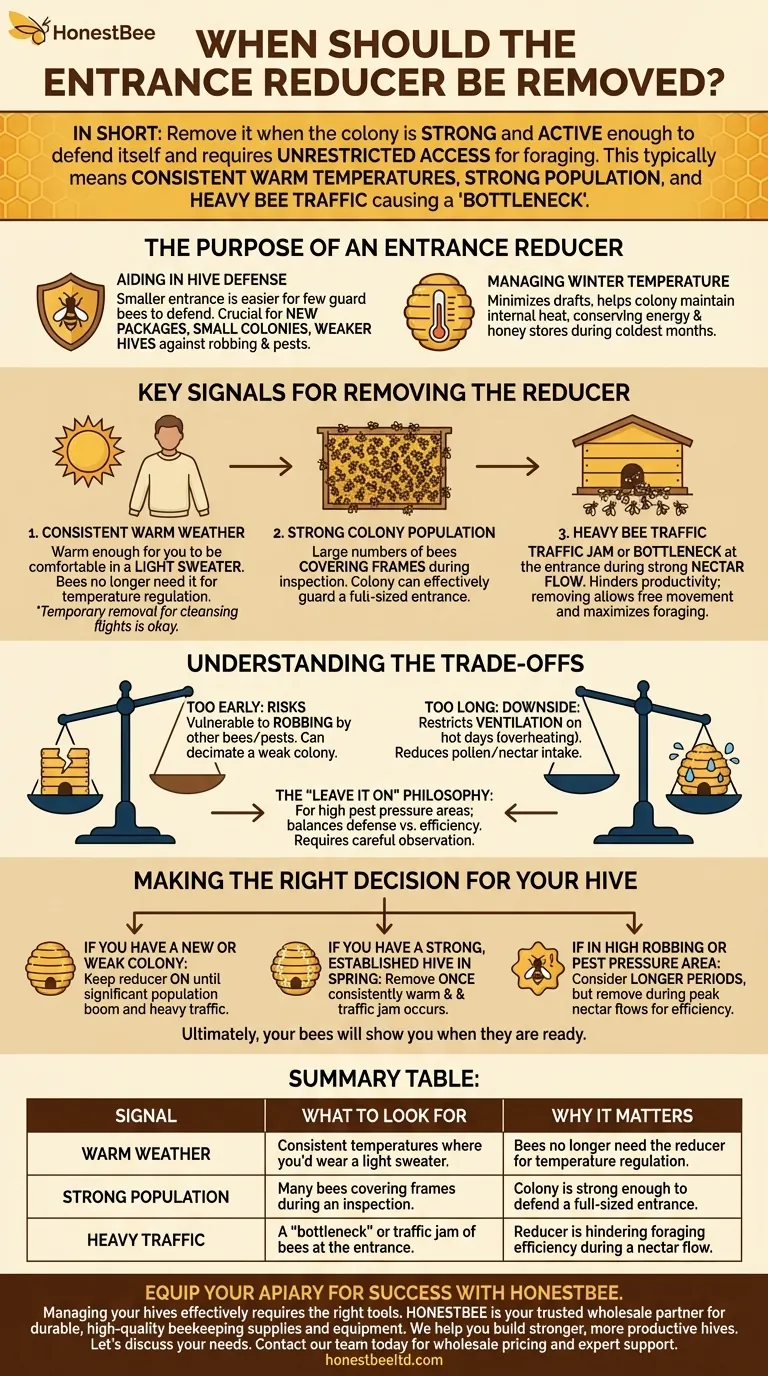In short, you should remove a beehive entrance reducer when the colony is strong and active enough to defend itself and requires unrestricted access for foraging. This typically occurs when temperatures are consistently warm and you observe heavy bee traffic, creating a "bottleneck" at the entrance during a strong nectar flow.
The entrance reducer is a temporary tool, not a permanent fixture. Its primary purpose is to help a small or weak colony protect itself. The decision to remove it should be based on the hive's specific strength and activity levels, not a fixed date on the calendar.

The Purpose of an Entrance Reducer
Before deciding when to remove it, it's critical to understand why you used it in the first place. An entrance reducer serves two primary functions.
Aiding in Hive Defense
A small entrance is much easier for a few guard bees to defend. This is crucial for newly installed packages, small colonies, or weaker hives that are vulnerable to being robbed by stronger hives or attacked by pests like wasps.
Managing Winter Temperature
During the coldest months, a reduced entrance helps the colony maintain its internal temperature. It minimizes drafts and reduces the space the bees must heat, conserving their energy and honey stores.
Key Signals for Removing the Reducer
Observe your hive for these three signs. They often occur together and signal that the colony is ready for more space.
1. Consistent Warm Weather
A simple and effective guideline is when the weather is warm enough for you to be comfortable outside in a light sweater. This indicates that the bees no longer need the reducer for temperature regulation.
On warmer winter days, it can be beneficial to temporarily remove the reducer to allow the bees a cleansing flight, then replace it as temperatures drop.
2. Strong Colony Population
A strong, populous hive is its own best defense. When you see a large number of bees covering the frames during an inspection, it's a clear sign that the colony has enough members to effectively guard a full-sized entrance.
3. Heavy Bee Traffic
This is the most compelling reason to remove the reducer. During a strong nectar flow in spring or summer, you may notice a traffic jam of bees at the entrance. Foragers will be backed up trying to get in and out, which directly impacts their efficiency.
This bottleneck is a clear indicator that the reducer is hindering the hive's productivity. Removing it allows the bees to move freely and maximize their foraging efforts.
Understanding the Trade-offs
The decision to remove an entrance reducer is a balance between protection and productivity.
The Risk of Removing Too Early
If you remove the reducer before the colony is sufficiently strong, you leave it vulnerable. The primary risk is robbing, where bees from other hives invade to steal honey, which can decimate a weak colony.
The Downside of Leaving It On Too Long
Leaving the reducer in place on a booming hive can cause problems. It restricts ventilation on hot days, which can contribute to overheating, and it directly reduces the amount of pollen and nectar the colony can bring in.
The "Leave It On" Philosophy
Some beekeepers, particularly those in areas with high pest pressure, choose to leave a reducer on year-round. They believe the added defensive benefit outweighs the potential reduction in foraging efficiency. This is a valid strategy but requires careful observation.
Making the Right Decision for Your Hive
Evaluate your specific situation to make the best choice.
- If you have a new or weak colony: Keep the entrance reducer in place until you see a significant population boom and heavy foraging traffic.
- If you have a strong, established hive in spring: Remove the reducer once temperatures are consistently warm and you see bees creating a traffic jam at the entrance.
- If your hive is in an area with high robbing or pest pressure: Consider using the reducer for longer periods, but be prepared to remove it during peak nectar flows to improve ventilation and efficiency.
Ultimately, your bees will show you when they are ready for the training wheels to come off.
Summary Table:
| Signal | What to Look For | Why It Matters |
|---|---|---|
| Warm Weather | Consistent temperatures where you'd wear a light sweater. | Bees no longer need the reducer for temperature regulation. |
| Strong Population | Many bees covering frames during an inspection. | Colony is strong enough to defend a full-sized entrance. |
| Heavy Traffic | A "bottleneck" or traffic jam of bees at the entrance. | Reducer is hindering foraging efficiency during a nectar flow. |
Equip your apiary for success with HONESTBEE.
Managing your hives effectively requires the right tools and knowledge. Whether you're a commercial apiary scaling your operations or a distributor supplying the beekeeping community, HONESTBEE is your trusted wholesale partner for durable, high-quality beekeeping supplies and equipment.
We help you build stronger, more productive hives. Let's discuss your needs.
Contact our team today for wholesale pricing and expert support.
Visual Guide

Related Products
- Multi-Functional Rotary Hive Entrance Disc for Beekeeping
- Multi-Functional Sliding Hive Entrance for Beekeeping
- Professional Reversible Beehive Hive Entrance
- Professional Galvanized Hive Strap with Secure Locking Buckle for Beekeeping
- Endless Loop Ratchet Hive Strap
People Also Ask
- What does a fully closed setting on a round beehive entrance disc indicate? A Guide to Hive Security
- What are the adjustable functions of the circular metal beehive entrance disc? Master Hive Access Control
- What are the four entrance options provided by the steel entrance disc? Master Hive Traffic & Protection
- What are some alternative strategies to using entrance reducers? Empower Your Bees for Natural Hive Defense
- How does entrance configuration vary seasonally for beekeepers? A Guide to Year-Round Hive Health



















